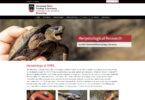Aiken, S.C. – Thanks to the hard work of conservationists across the United States, the once imperiled American wood stork has been down-listed from endangered to threatened by the U.S. Fish and Wildlife Service. Among the many organizations responsible for bringing the large wading bird back from the brink of extinction are the University of Georgia’s Savannah River Ecology Laboratory and the U.S. Department of Energy.
SREL’s efforts began in 1983 with an extensive study of the wood stork’s biology on the Savannah River Site and their nesting colony in Jenkins County, Georgia. The studies documenting their nocturnal feeding patterns, genetics, uptake of mercury and regional movements were the first of their kind in the bird’s northern range.
Access to the stork’s nourishing wetlands was reduced in 1985 when the Savannah River Site resumed operation of L-reactor, one of its nuclear reactors. Use of the reactor ended in 1988. SREL and DOE expanded efforts to protect the stork’s habitat through collaboration with the National Audubon Society.
In 1986, 25 acres of managed ponds were constructed at Kathwood Lake using DOE funding. These areas serve as necessary feeding grounds for the storks. Four man-made habitats on Silver Bluff Audubon Center and Sanctuary in Jackson, South Carolina, were supplied with fish and their water levels were managed to mimic stork habitats. In 1995, the National Audubon Society assumed overall responsibility for the maintenance and operation of wood stork feeding ponds.
“More than 90 storks were seen on one pond, in one day, during that first year,” said Larry Bryan, senior research professional at SREL and lead biologist on the project. That number was considered a sign of success by regulating agencies, he said.
Those numbers have grown considerably. Two hundred wood storks were observed on one of the ponds in September 2013, according to Paul Koehler, director of the Jackson center.
SREL and the U.S. Fish and Wildlife Service published “Wood Stork Conservation and Management for Landowners” in 2001, a detailed brochure that informs landowners of the stork’s protected status and provides conservation techniques.
SREL scientists have contributed 50 peer-reviewed articles to scientific literature, providing a better understanding of the ecology and behavior of the wood stork. The lab remains involved in stork research throughout the Southeast.
Savannah River Ecology Lab
SREL is a research unit of UGA, located in Aiken, South Carolina, on the DOE’s Savannah River Site. The laboratory pursues basic and applied ecological research, provides graduate and undergraduate training and educates the public through extensive community outreach. For additional information about SREL, see www.srel.uga.edu.







